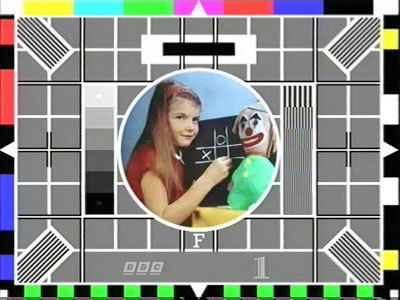
When Brits of a certain age imagine snapping on the telly, they find Test Card F burned into their retinas. An irregular grid of gray-and-white squares, each corner bisected at the diagonal with bold stripes. In the center floats a circle that, fish-eye-like, reveals a scene begging for explanation: a little girl in an Alice hairband plays tic-tac-toe (or, to use the game’s British name, “noughts and crosses”) with a hideous clown doll. Transmitted late nights and during the workday, Test Card F ruled off-hours BBC television from 1967 to 1998, dwindled rapidly into non-existence with the rise of 24-hour programming. The girl and clown have been locked in a “never-ending game… reminiscent of the feudal knight taking on Death at chess in Ingmar Bergman’s The Seventh Seal” for over 70,000 hours, making Test Card F the longest-running TV broadcast in British history.
I stumbled on this enigmatic image while writing my latest book Patternalia: An Unconventional History of Polka Dots, Stripes, Plaid, Camouflage, & Other Graphic Patterns. It fell outside my research focus—the book decodes the cultural histories of graphic patterns across the globe—but grabbed firmly onto my lapels and held. Patternalia started with an irrational, but persistent observation I had: why do we imbue individual patterns with a sense of personality? Why should polka dots seem demure and female, or Hawaiian-prints obnoxious and boorish, or stripes speedy and decisive? Writing this book was all about taking that nutso question seriously, and tracking down some definitive answers.
While Test Card F isn’t, strictly speaking, a graphic pattern in the tradition of plaid or fleur de lis, it’s absolutely earned its place in the pantheon of repeated imagery in daily life that’s too often ignored. “The ephemeral is not the opposite of the eternal,” art critic John Berger wrote in his 2008 book From A to X: A Story in Letters. “The opposite of the eternal is the forgotten.” For millions of Britons in the heart of the previous century, Test Card F papered hours and days and years with the same inscrutable picture. I conjure it up in my mind’s eye: a square of cracklingly live wallpaper you could switch on and off, the telly’s default image, the ghostly underside of all programming. Its intermittent visiblity probably wouldn’t have diminished how enveloping and endless it felt—just like any fascinating wallpaper.
This mesmerizing image rewards parsing. Created by former BBC engineer George Hersee, his 2001 BBC obituary explains the technological moment that gave rise to Test Card F: Prior to color televisions, TV installers made do with scientifically abstracted testcards to refine reception. But “colour TV presented new problems,” writes the BBC obituary writer. “It was deemed necessary to include a picture of a person on the new test card so adjustments could be made for flesh tones.” Hersee dashed off a few mockups featuring his daughters Carole and Gillian, never dreaming Carole’s face would eventually rival the Queen’s for totalizing ubiquity. The BBC preferred using a child in Test Card F versus an adult, as children’s fashions tended to age less rapidly.
The apparently haphazard details depicted in Test Card F are no accident. The chalk X on the blackboard was carefully positioned to help engineers center the TV picture. While the BBC briefly toyed with using an Asian child wearing a bindi for this purpose, the cross proved more useful. Color images in TV are made of overlapping red, green and blue layers; any “fringing” or color bleed into the cross revealed poor convergence in the TV signal. Similarly, the evil clown Bubbles’ buttons should appear yellow, not white. If the yellow “jumps” to the right and the buttons look white, that signals a chrominance/ luminance delay error.
Like a ghost transmission from outer space, Test Card F’s cultural half-life may last much longer than its broadcast history. Parodies of the iconic poses of the two characters abound – from the Mighty Boosh comedians of modern-day BBC fame, to a cameo “Poem Girl” in front of a test-card-like backdrop in a recent Doctor Who episode. 3D television sets demand their own test cards for fine-tuning reception. In 2011 Sky3D released a 3D test card pairing TV presenter Zoe Ball with her modern-day clown, one “Mr. 3D”, an empty suit complete with black turtleneck and floating Buddy Holly eyeglasses. Naturally Zoe stands in Carol’s spot, Mr. 3D in Bubble’s. British fan-club The Test Card Circle is two-hundred members strong and devoted to all things Test Card F, with a peculiar fascination with its accompanying music. In truly spooky fashion, one can find reams and reams of online documentation about this music, but actual audio is scarce.
Perhaps the longest-running afterlife of Test Card F came in the semi-recent BBC television series Life on Mars. Hugely popular during its brief run (2006—2007), the show featured a recurring, elusive character named “Test Card Girl”. Life on Mars depicted a policeman, Sam Tyler, who’s abruptly whisked from his present-day life to 1973, although it’s left maddeningly vague whether he’s traveled back in time, trapped in a coma, mad or actually dead. Whenever Sam falls asleep with the TV on—an entirely common occurrence after hitting the pubs, 70s-bad-behavior-style—he wakes to hallucinations of Test Card Girl taunting him. As the show’s co-creator Matthew Graham told The Radio Times, “The Test Card girl represents the devil in Sam Tyler, teasing and torturing him. But there is another factor to consider. In 1973, when television transmission had ceased for the night, when the story is done and the characters have vanished into nothing, the BBC would switch to the Test Card girl. So she, if you want to be melodramatic, represents the apocalypse, the end.” Fittingly, the show’s finale ends with Test Card Girl turning a switch, and the screen snaps to black like an old television set.




